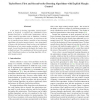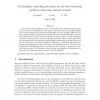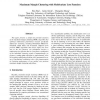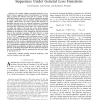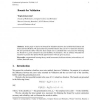121
Voted
CVPR
2011
IEEE
14 years 4 months ago
2011
IEEE
A new family of boosting algorithms, denoted TaylorBoost, is proposed. It supports any combination of loss function and first or second order optimization, and includes classical...
141
click to vote
TNN
2010
14 years 7 months ago
2010
Clustering using the Hilbert Schmidt independence criterion (CLUHSIC) is a recent clustering algorithm that maximizes the dependence between cluster labels and data observations ac...
109
Voted
SAC
2010
ACM
14 years 7 months ago
2010
ACM
The label switching problem is caused by the likelihood of a Bayesian mixture model being invariant to permutations of the labels. The permutation can change multiple times betwee...
101
Voted
INTERSPEECH
2010
14 years 7 months ago
2010
This paper describes improvements in a search error risk minimization approach to fast beam search for speech recognition. In our previous work, we proposed this approach to reduc...
102
click to vote
ICDM
2009
IEEE
14 years 10 months ago
2009
IEEE
This paper presents a simple but powerful extension of the maximum margin clustering (MMC) algorithm that optimizes multivariate performance measure specifically defined for clust...
130
click to vote
COLT
2010
Springer
14 years 10 months ago
2010
Springer
Bandit convex optimization is a special case of online convex optimization with partial information. In this setting, a player attempts to minimize a sequence of adversarially gen...
TIT
1998
15 years 18 hour ago
1998
Abstract— We consider adaptive sequential prediction of arbitrary binary sequences when the performance is evaluated using a general loss function. The goal is to predict on each...
105
click to vote
ML
2002
ACM
15 years 1 days ago
2002
ACM
In this paper, we elaborate on the well-known relationship between Gaussian Processes (GP) and Support Vector Machines (SVM) under some convex assumptions for the loss functions. ...
FUIN
2006
15 years 11 days ago
2006
In this paper we derive the bounds for Validation (known also as Hold-Out Estimate and Train-and-Test Method). We present the best possible bound in the case of 0-1 valued loss fun...
107
Voted
ADCM
2007
15 years 15 days ago
2007
In this paper, we are interested in the analysis of regularized online algorithms associated with reproducing kernel Hilbert spaces. General conditions on the loss function and st...
